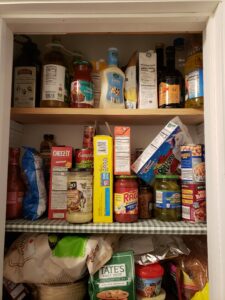The UK has recently been put in its third lockdown due to the COVID-19 pandemic. I know from experience that it can be hard to motivate ourselves to eat healthily and exercise under the circumstances. This is especially so if you have to work from home or have children that you need to support with their home learning. Thus, to help you out, this guest post on Easy Nutrition Tips During Quarantine by Dominick Uguccioni is just what you need.
Easy Nutrition Tips During Quarantine and a pandemic:
During uncertain the uncertain times of the COVID19 pandemic, attending to our health, well being, and nutrition is more challenging than ever. Thankfully, there are quick and easy tips to choose the most healthy, shelf stable food, regardless of availability and supply chain. Read on to learn the top 3 ingredients in food to avoid, and how to tell if they are in the food you are about to buy or eat.

Challenges of Nutrition During Quarantine
Lets face it, grocery shopping and day to day life are different during 2020, all over the world. In addition to risk, fear, and social distancing measures needing to be followed, the global supply chain has been interrupted and foods/goods which were in abundant supply may be more scarce. Out of concern for the supply chain, some of us may try to stock up on goods and shelf stable food. But, shelf stable food is generally highly processed, and not ideal for health and well being. Right? Not necessarily.
It is possible to find foods that are both healthy/nutrient dense, and shelf stable. The general wisdom is that fresh, whole foods are best for you, and packaged food is usually highly processed. Typically, this is a helpful guideline to follow, however we are not living in typical times. Read on to find out how you can avoid the top three harmful processed ingredients, and make healthy, shelf stable food choices.
The Top 3 Unhealthy Ingredients, and How to Tell If They Are in Your Food
The top 3 unhealthy categories of ingredients in packaged food are:
1. Refined Sugar
2. Refined Oil
3. Refined Grains
In addition to being the most problematic, these are the most commonly found ingredients in processed food. Why? They are cheap to manufacture, they taste good (so we keep buying them) and they are shelf stable. The problem with all of these foods is that they have been altered from their natural state, and have adverse impacts on our blood sugar, insulin response, digestion, inflammation levels, and generally they are manufacture to taste good and are easy to over eat.
The problem is, these ingredients do not appear on a nutrition label the way I just listed them above. Here is how you can be a detective and track them down:
Any food in a box, bag, or package needs to have a nutrition label. Start there are look by category:
1. Refined Sugar: Commonly listed as High Fructose Corn Syrup, Sucrose, Maltose, Dextrose, Brown Rice Syrup, Sugar, Brown Sugar, Lactose. If you see anything with key words “sugar”, “syrup”, or ending in letters “ose” it is a refined, added sugar.
Think of eating an apple. An apple has natural sugar called fructose in it. An apple also has water content, and dietary fiber you need to chew and process. High fructose corn syrup can be added to food and drinks, and can be consumed in much higher amounts. What is easier/more likely to happen…to eat 5 apples, or drink a 20 ounce bottle of soda?
2. Refined Oils: There are three main methods to process plant/vegetable oils. They are Cold Pressed, Expeller Pressed, Solvent Extracted. Cold Pressed is the least processed method, and does not use high heat to extract more oil. Expeller Pressed uses the same mechanism as a Cold Press, however high heat is used to extract more oil (can denature the nature structure/composition of the oil). Solvent extraction involves using a chemical like Hexane to pull oil out of Soy Beans for example. This is used because it has very high yield, and therefor can be cheaply produced.
The problem with tracking these particular ingredients down, at least in the United States, is that solvent extracted oil does not have to be labeled as such. In the US, if any oil is listed on the ingredients list (Soy Bean Oil) it can be assumed that it is solvent extracted unless clearly listed as Cold Pressed or Expeller Pressed. Basically, in oil you see listed in chips, cookies, crackers, snacks that you buy in the store is likely to be solvent extracted, and is good to stay away from.
3. Refined Grains: Refined Grains are problematic because the manufacturing process alters the natural state of the grain and removes most of the dietary fiber. Key words to look for in packaged food are “unbleached flour”, “enriched or fortified flour”, “corn flour”, “rice flour” and other variations.
This eliminates a lot of store bough breads, cereals, chips, cookies, crackers, snacks. If you look at some of the above, you will likely notice they have all 3 (refined sugar, refined oil, refined grains).
Eat This, Not That
So, what are some better choices to make when shopping for more shelf stable foods during this pandemic? Here are some good choices by category. Please make sure you read the label of everything, these ingredients can be sneaky!
1. Fruit and Vegetables: If fresh produce is not available, here are some possible options for fruit and veggies: pickles, sauerkraut, canned beans, canned vegetables, flash frozen fruits or vegetable, salsa, guacamole, humus. With all of the above, read the ingredients, refined sugar is sneaky and can make it in to a lot of the options listed. Canned fruit can be tricky, as it is usually packed in a syrup with extra sugar.
2. Meat and Fish: If fresh is not available. Sardines, canned Salmon, canned Fish, Beef Jerky and other dried meat sneaks (carefully reading the label for sugar). Frozen meats are a stable option as well. Always try to buy meats and fish on their own and prepare/season yourself. If you buy meat or fish as part of a prepared meal (you will see these other ingredients creep in)
3. Grains: Whole Oatmeal, Whole Grain Rice (without added seasoning/flavor packets, season yourself so you know what is going in), Ancient Grains, Whole Corn, Barley, Quinoa. With any grains, you want to buy the grains in their whole state and cook with them/use them on your own. Make your own bread, crackers, side dishes, and snacks from whole grains rather than buying a packaged grain product.
4. Dairy: Basically, any milk, yogurt, cheese, eggs in their natural state will not include any of these ingredients. Beware of processed cheese, flavored milk and yogurt products. Any dairy product by nature is not shelf stable, however it is still important to be on guard for mystery ingredients.
Not a Fad Diet
The approach above is applicable regardless of the dietary plan you are following. I use the term “fad diet” not to poke fun at any particular method of eating, but to demonstrate that the science is settled on the processed ingredients I mentioned above. For example, if you ask:
– A Vegan
– Someone on Keto Diet
– Someone on Paleo Diet
– A Nutritionist
– A Vegetarian
“If I remove refined sugar, refined oil, and processed grains from my diet, is that a healthy choice?” All of the above will have different ideas on what you should eat and how you should be eating, but they will say “yes” to that question. If someone ever answers “no” to that question, ask them how science has shown that eating refined sugar, oil, and grain specifically improves our health.
The simple fact is the our genetics have not changed very much in the last 2,000 years, whereas food processing and manufacturing has dramatically changed in the last 100 years. The modern processing methods are very helpful for mass production, shelf stability, and making a tasty product, however out bodies are simply not designed to digest them and use them as fuel
CONCLUSION on Easy Nutrition Tips During Quarantine
Try this method the next time you are shopping, you will be surprised to find how many packaged foods include all three of these problematic ingredients. You will also be surprised at how many shelf stable foods do not have these ingredients, and how easy it is to stock up for these uncertain times. Thank you, and be well everyone!
About Dominick Uguccioni
I am a Health and Fitness Blogger, Husband, Father, and Higher Education Professional living in Massachusetts, USA. Please click here to visit my website to find out more about what I do.
***
If you enjoyed reading this guest post on Easy Nutrition Tips During Quarantine by Dominick Uguccioni, please leave a comment below with your thoughts and share the post with everyone in your network. I would also like to know of any Easy Nutrition Tips During Quarantine you have.





great article thanks
Great post, Dominick! Your guest post on Easy Nutrition Tips During Quarantine is incredibly helpful. It’s true that during these challenging times, it can be difficult to prioritize our health and nutrition. Your practical tips on choosing healthy and shelf-stable foods are invaluable. The insights on the top three unhealthy ingredients and how to identify them in packaged foods are particularly eye-opening. Being aware of refined sugar, refined oil, and refined grains and knowing how to detect them by deciphering nutrition labels is empowering.
Such useful content! I love when people like you make learning easier for other people. Like you, I’m also working on my blog, and thanks for sharing this article.
Thank you for stopping by, I appreciate your comment 😀